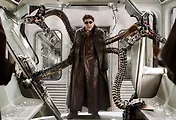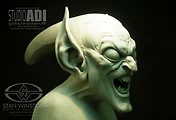




















Villains for The Dark Knight Rises would present Lindy Hemming with a fresh set of challenges, but by the time she began designing the costume for Bane, The Dark Knight Rises's villain, she was fully steeped in Nolan's method of working, which entailed one-on-one collaboration in the very earliest stages of the film's development, even before a final screenplay had been written. "I love how we work on these films," Hemming said, "the fact that we actually work together with Chris in pre-production and spned time talking about the characters. We'd developed that apporach on the other films, and I looked forward to continuing ti on this one."
The key to desgning Bane's costuem, as for those of all the characters in the trilogy, was first determining the function it served. That held especially true for his mask. In the comics, Bane had worn the coloful, full-head mask of a luchadorㅡa Mexican-style wrestlerㅡbut in The Dark Knight Rises, the mask would require a more industrial look, as it served a practical purpose: pumping a continuout dose of anesthetic into Bane's system to help alleviate his chronic pain.
After drawing many, many interations of the mask on photographs of bald actors such as Marlon Brando and Terence Stamps, Nolan and the desingers came to the realization that for purpose of clarity, Bane's mask would have to create a very different silhouette than Batman's. "A lot of the film was going to take place in the dark, with Bane and Batman fighting," Hemming explained, "and we couldn't have one black lump of a head fighting another balck lamp of a head. And so, to make sure they would be easily identifiable, we had to make those two silhouettesㅡBatman's and Bane'sㅡlook completely diffent."
The search for a distinctive silhouette for Bane led to the designers removing pieces of the full-head mask to create a more streamlined, minimalist look. "I'd been playing with all kind of elaborate tubing and devices for the mask," said Hemming, "but all of that had to be streamlined, because as we made the mask smaller, there was no place to put it all. So the mask was juse reduced and reduced. I also wanted the mask to look animalistic, like something that might bite you, and so referenced a lof of gorillas and spiders and the like."
Once Tom Hardy was cast in the role, sculptors sculpted the mask onto a plaster form of the actor's head, created from cyber-scanning, a technique in which laser beams are bounced off a subject to create a computer-generated-3D representation of the subject. "A cyber-scan is like a photograph in the computer," said Graham Churchyard, "and then that photograph is re-created as a three-dimensional head from that you can sculpt on in clay."
The approved clay design was then re-sculpted in the computer and fit, piece by piece, over a digital rendering of Tom Hardy's head. When that digital mask was generated as a prototype prop, it fit so tightly that it restriced Hardy's breathing. "We always knew the breathing was going to be a problem," said Churchyard, "but we had to start with that finished mask before we could begin hollowing out the tubes to help him to breathe. Tom hated it the first time we put it on him."

"It really gripped his head like a vise," Hemming affirmed, "but Tom was amazing patient about that. We designed it with magents underneath the front panel, so it could be removed easily. The layer below that was rubber to created a kind of gasketlike seal. The gasket pressed into his skin by tension, so it created the feeling of a very hardpressed, tightly sealed thing. It was a big challenge for an actor to have to perform behind that thing, to not have his mouth on view. Tom put up with it really well."


A particulary interesting sound challenge was Bane's maks, conceived as an industrial construct of tubes and motors that continually pumps medication into Bane's body. "What was recorded on the set had no sense of the sounds those mask tubes would make," said King. "There was just this muffled voice, picked up by the boom mic, and then a close sort of tinny vocice picked up by the radio mic inside the mask, which was about five millimeters from his mouth. So we had to created the sound of the mask, but without getting in the way of the performance. It just had to exist there in the background, and tehn, every now and then, make itself felt."
As the filmmakers began screening the prologue in the winter of 2011, some audience members expressed an inablity to clearly understand Bane's dialogue from behind the mask. Nolan knew that the roar of the planes' engines in the prologue exacerbated the problem, and he remained confident that in nonaerial scenes, Bane's dialogue would be clearly audible.
Ultimately, the quality and clarity of Bane's dialogue would be, to a large extent, determined by the way it was mixed into the soundtrackㅡand Nolan was as involved in that final mix as he was in every other aspect of making the film. "He has the best ears of anybody that I've ever met," said King. "He can hear things that most people can't hear. And I've learned the hard way that when he thinks he hears something, he's right. He will hear something in the mix that nobody else hearsㅡand then, when we isolate the sound, we find that he was right. He's like that with everything, really."
'영화 Cinema > Marvel, DC' 카테고리의 다른 글
| [DB] 스파이더맨 뉴 유니버스 디자인 Spider-Man Into the Spider-Verse (2018) (0) | 2022.12.12 |
|---|---|
| [DB] 투페이스 다크나이트 The Dark Knight Two Face (0) | 2022.12.10 |
| [DB] 닥터 옥토퍼스 스파이더맨 Spiderman Dr.Octopus (0) | 2022.11.16 |
| [DB] 그린고블린 스파이더맨 Spiderman Green Goblin (0) | 2022.11.04 |
| [DB] 더 배트맨 코스튬 디자인 The Batman Costume Design (0) | 2022.10.06 |



